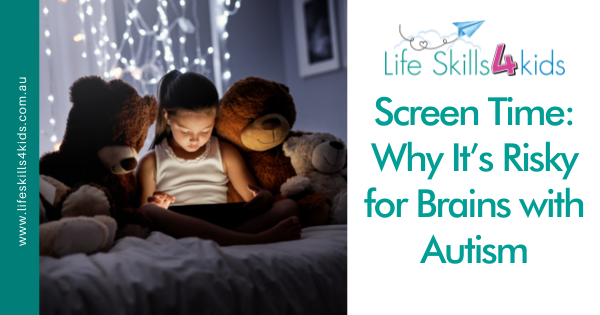Correlation Does Not Equal Causation
While there are definite links between screen time and its effects on an autistic brain, it’s important to note that screen time has not been proven to cause autism. One Swedish study in 2014 concluded that the cause is likely a 50/50 split between environmental and genetic factors. As a complex disorder, many other related factors also lie in the origins of the disorder within individuals.
Why are Autistic Brains more Vulnerable to the Effects of Screen Time?
Although we are all susceptible to the effects of excess screen time to one degree or another, young brains are more vulnerable than adults, and it affects children and young people with ASD much more than anyone else. This is because the unique characteristics of a brain with ASD lend themselves far more readily to the disruption and chaos caused within the brain by screen time. ASD brains are not wired to readily process the regular use of technology without side-effects.
Not only are children with ASD more susceptible to the harmful effects of screen time, but they are also less able to recover. The effects last longer and have a deeper impact simply because their brains are not wired to cope. They are more sensitive, less resilient and more prone to lasting effects.
What Does Excess Screen Time Do to Children with ASD?
Excess screen time has a profound effect on the behaviour and coping mechanisms of children with ASD. These include the following;
-
Exacerbated Arousal Regulation Issues
Children with ASD often struggle with arousal regulation issues such as emotional dysregulation, exaggerated responses to stress, and a tendency to be either overstimulated or understimulated [1]. Excess screen time exacerbates all of these issues and manifests itself as exaggerated emotional dysregulation and increased likelihood of acute and chronic stress. It also causes overstimulation and hyperarousal [2].
-
Augmented Sleep Disturbances
Children with ASD often suffer from low melatonin, leading to sleep disturbances, particularly when technology is used at night [3]. Melatonin regulates the body clock and is critical for normal sleeping and waking patterns. It also works with other hormones to keep the brain chemistry balanced, plays a part in regulating immunity, and lowers inflammation. Excess screen time suppresses the production of melatonin, leading to even greater problems with sleep in children with ASD.
-
Increased Social and Communication Deficits
Screen time hinders the development of social and communication skills – even in children and teens that don’t have ASD [4]. This manifests as an inability to make eye contact, impaired ability to read body language, low levels of empathy and a delay in gaining language skills.
-
Higher Anxiety Levels
Children with ASD are prone to anxiety and screen time increases the risk of social anxiety and OCD issues. In addition, children with autism have been shown to be at greater risk of abnormal serotonin synthesis and amygdala activity and changes in amydala activity and serotonin regulation have been observed as a result of screen time [5].
-
Magnified Sensory Processing Issues
Children with ASD are more likely to experience sensory and motor integration problems such as sensory processing disorders, tics, and vocal and motor delays. Screen time worsens these issues, particularly sensori-motor delays. Tics may also worse due to higher dopamine levels.
Strategies to Help Families Reduce or Eliminate Screen Time
-
Educate Families About the Risks of Screen Time on an Autistic Brain
For many families, the use of technology is tempting because it restores peace, at least for a short time. So it is important that families understand the benefits of reducing or eliminating technology or they may be unwilling to try something new.
-
Encourage Families to do a Technology Detox
When families understand how technology use affects the brain of a child with ASD, initiating change is easier. Encourage them to try it for a specified time period (4 weeks is a good length of time to aim for) and see if it makes a difference.
-
Come up with Strategies to Replace Screen Time
Weaning a child off a favourite device will be more successful if parents have a plan in place ahead of time to replace that time with something more interesting or engaging. This will be something that fits each family’s unique dynamics, but memory-making events, spending time together out in nature, and playing together are options that can work well.
-
Encourage Parents to Limit their Own Technology Use
Encourage parents to model what they are trying to achieve. When children see that parents are not using technology either, they are more likely to accept the family’s decision to limit or eliminate screen time from family life.
-
Educate Parents about Healthy Sleep Habits
Some parents are not aware of the effects of screen time on sleeping habits – even for children and teens that don’t have ASD. Encourage parents to turn off all technology at least 2 hours before bedtime and establish regular bedtime routines and rituals. Preparing a child’s brain for bed is half the battle won.
If you would like to know more about screen time and autism, get in touch and call Deb or send us an email. We’ll be happy to talk to you!
References:
[1]. Matthew S. Goodwin et al., “Cardiovascular Arousal in Individuals with Autism,” Focus on Autism and Other Developmental Disabilities 21, no. 2 (2006): 100–123; BA Corbett and D Simon, “Adolescence, Stress and Cortisol in Autism Spectrum Disorders.,” OA Autism 1, no. 1 (March 1, 2013): 1–6.
[2]. Marjut Wallenius, “Salivary Cortisol in Relation to the Use of Information and Communication Technology (ICT) in School-Aged Children,” Psychology 1, no. 2 (2010): 88–95; Amy E. Mark and Ian Janssen, “Relationship between Screen Time and Metabolic Syndrome in Adolescents,” Journal of Public Health 30, no. 2 (June 1, 2008): 153–60; Gary S. Goldfield et al., “Video Game Playing Is Independently Associated with Blood Pressure and Lipids in Overweight and Obese Adolescents,” ed. Philippe Rouet, PLoS ONE 6, no. 11 (November 1, 2011): e26643.
[3]. ] Shigekazu Higuchi et al., “Effects of Vdt Tasks with a Bright Display at Night on Melatonin, Core Temperature, Heart Rate, and Sleepiness,” Journal of Applied Physiology (Bethesda, Md.: 1985) 94, no. 5 (May 2003): 1773–76.
[4]. R. Adolphs, L. Sears, and J. Piven, “Abnormal Processing of Social Information from Faces in Autism,” Journal of Cognitive Neuroscience 13, no. 2 (February 15, 2001): 232–40.
[5]. Jun Kohyama, “Neurochemical and Neuropharmacological Aspects of Circadian Disruptions: An Introduction to Asynchronization,” Current Neuropharmacology 9, no. 2 (2011): 330; Klaus Mathiak and René Weber, “Toward Brain Correlates of Natural Behavior: fMRI during Violent Video Games,” Human Brain Mapping 27, no. 12 (December 2006): 948–56.
Relaxation for Kids Meditation Script
With so many uncertainties in the world and with childhood and adulthood anxiety on the increase, it’s my mission to reach out and support as many children and adults who suffer from anxiety as I can. This mindfulness meditation that includes a script and an audio mp3 about finding your safe place is one tool that I share with you.


